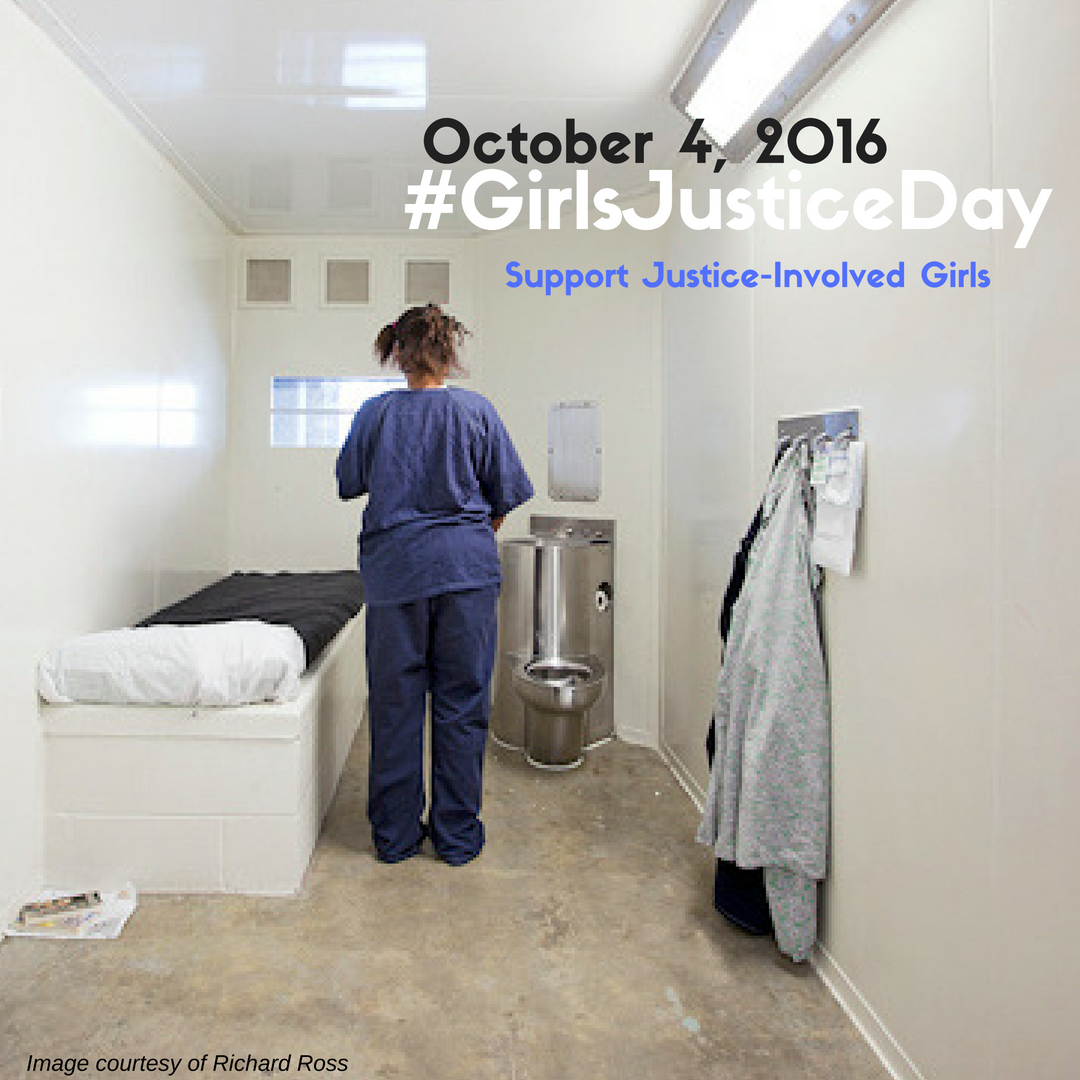Girls Justice Day Action Kit

- October 4, 2016
- During National Youth Justice Action Month in October, the Campaign for Youth Justice wants to highlight the strength, resilience, and needs of girls who have had contact with the juvenile or adult justice systems. For more information on the experiences that push girls into the system and what you can do to take action on behalf of girls, check out the tool kit below.
Reports:
The Sexual Abuse to Prison Pipeline: The Girls Story
OJJDP Policy Guidance: Girls in the Juvenile Justice System
Gender Injustice: System-Level Juvenile Justice Reforms for Girls
No Place for Youth: Girls in the Adult Justice System
Organizations:
Rights4Girls
The National Crittenton Foundation
National Resource Center for Justice Involved Women
OJJDP National Girls Initiative
Take Action: Share Information about Girls Justice Day with friends & family on social media!
Sample Facebook Post:
- Minimize harm to girls in the system
- Provide appropriate programming and services
- Use gender- and age-appropriate classification tools and risk and needs assessments
- Create opportunities for Relationship Building with Peers, Family Members, and Community Supports and Resources
- Provide Off Ramps Out of the System
- Listen to Girls
Too many girls are behind bars because of the #AbusetoPrisonPipeline. Learn more about supporting justice-involved girls and what Girls Justice Day is all about! http://bit.ly/1fp0qfM
Tell Your Senator to Vote in Favor of the Reauthorized Juvenile Justice and Delinquency Prevention Bill: H.R. 5963. H.R. 5963, the Supporting Youth Opportunity & Preventing Delinquency Act because it will provide greatly needed supports for justice-involved girls, such as:
- Incentivizing states to create prevention programming for girls at-risk of entering the juvenile justice system;
- Screening girls in the juvenile justice system for child sex trafficking and diverting them towards community-based programming wherever possible;
- Ending the use of unnecessary restraints on pregnant and post-partum girls;
- Encouraging states to limit the use of the Valid Court Order exception, which has led to the disproportionate detention of girls who commit non-violent offenses.
Sample Tweets
Keep girls safe and out of the adult justice system! #GirlsJusticeDay http://bit.ly/2dzsFLJ
Keep girls safe! Girls do not belong in adult facilities. #GirlsJusticeDay http://bit.ly/2dzsFLJ
Adult facilities are no place for girls #GirlsJusticeDay http://bit.ly/2dzsFLJ
Bresha Meadows is a victim of the #AbuseToPrisonPipeline. Girls deserve protection, not jail. #GirlsJusticeDay http://bit.ly/1fp0qfM
Latesha Clay is a victim of #childsextrafficking. She deserves services not jail. #NoSuchThing #GirlsJusticeDay http://bit.ly/1fp0qfM
Pregnant girls behind bars should never be shackled. #GirlsJusticeDay http://bit.ly/2cTh0TV
Gynnya McMillen was one of too many girls arrested for behavior link to abuse within the home #GirlsJusticeDay http://bit.ly/2dzrewR
We must take action on behalf of the thousands of girls subjected to the #AbuseToPrisonPipeline #GirlsJusticeDay http://bit.ly/1fp0qfM
In our fight to end mass incarceration, we can’t forget #girlsbehindbars #GirlsJusticeDay http://bit.ly/1KKVhcv
Take Action: Tell Your Senator to Vote in Favor of the Reauthorized Juvenile Justice and Delinquency Prevention Bill: H.R. 5963.
- Find contact information for your U.S. Senator here: http://www.senate.gov/senators/contact/
- Email or call your Senator and tell him or her to support H.R. 5963, the Supporting Youth Opportunity & Preventing Delinquency Act because it will provide greatly needed supports for justice-involved girls, such as:
- Incentivizing states to create prevention programming for girls at-risk of entering the juvenile justice system;
- Screening girls in the juvenile justice system for child sex trafficking and diverting them towards community-based programming wherever possible;
- Ending the use of unnecessary restraints on pregnant and post-partum girls;
- Encouraging states to limit the use of the Valid Court Order exception, which has led to the disproportionate detention of girls who commit non-violent offenses.
Take Action: Tell your Governor to prioritize the needs of girls in your state.
Sample Tweets:
@GovernorX keep girls safe and out of the adult justice system! #GirlsJusticeDay2016 http://bit.ly/2dzsFLJ
@GovernorX Girls should never be subject to the #AbusetoPrisonPipeline. Prioritize girls in your policies. http://bit.ly/1fp0qfM
AK – Bill Walker @AkGovBillWalker
AZ – Doug Ducey @dougducey
AR – Asa Hutchinson @AsaHutchinson
CA – Jerry Brown @JerryBrownGov
CO – John Hickenlooper @GovofCO
CT – Dannel Malloy @GovMalloyOffice
DE – Jack Markell @GovernorMarkell
DC – Muriel Bowser @MayorBowser
FL – Rick Scott @FLGovScott
GA – Nathan Deal @GovernorDeal
HI – David Ige @GovHawaii
ID – Butch Otter @ButchOtter
IL – Bruce Rauner @GovRauner
IN – Mike Pence @GovPenceIN
IA – Terry Branstad @TerryBranstad
KS – Sam Brownback @govsambrownback
KY – Matt Bevin @GovMatBevin
LA – John Bel Edwards @LouisianaGov
ME – Paul LePage @Governor_LePage
MD – Larry Hogan @LarryHogan
MA – Charlie Baker @MassGovernor
MI – Rick Snyder @onetoughnerd
MN – Mark Dayton @GovMarkDayton
MS – Phil Bryant @PhilBryantMS
MO – Jay Nixon @GovJayNixon
MT – Steve Bullock @GovernorBullock
NE – Pete Ricketts @GovRicketts
NV – Brian Sandoval @GovSandoval
NH – Maggie Hassan @GovernorHassan
NJ – Chris Christie @GovChristie
NM – Susana Martinez @Gov_Martinez
NY – Andrew Cuomo @NYGovCuomo
NC – Pat McCrory @PatMcCroryNC
ND– Jack Dalrymple @NDGovDalrymple
OH – John Kasich @JohnKasich
OK – Mary Fallin @GovMaryFallin
OR – Kate Brown @OregonGovBrown
PA – Tom Wolf @GovernorTomWolf
RI – Gina Raimondo @GinaRaimondo
SC – Nikki Haley @nikkihaley
SD – Dennis Daugaard @SDGovDaugaard
TN – Bill Haslam @BillHaslam
TX – Greg Abbott @GovAbbott
UT – Gary Herbert @GovHerbert
VT – Peter Shumlin @GovPeterShumlin
VA – Terry McAuliffe @GovernorVA
WA – Jay Inslee @GovInslee
WV – Earl Ray Tomblin @GovTomblin
WI – Scott Walker @GovWalker
WY – Matt Mead @GovMattMead